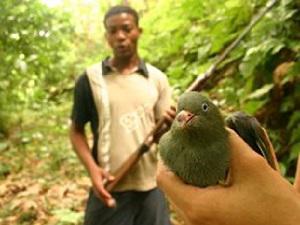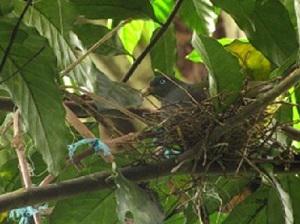Mariana Bastos Carvalho
This project aims to assess the current situation of bird hunting in São Tomé island and analyse its extent and impact on the endemic Columbidae birds, in order to suggest specific conservation measures and discuss options for its mitigation.

Hunter.
The islands of São Tomé and Príncipe are recognized biodiversity hotspots, and represent the second most important forests of Africa for birds. Despite this, bird hunting is widespread, for subsistence of commercial proposes, affecting mainly the endemic frugivorous Columbidae (pigeons and doves), which are poorly known and apparently diminishing in the São Tomean forests.

Treron nest.
This project will act as a baseline to promote conservation of the endemic species of Columbidae, as it will collect information on actual hunting pressure affecting these birds, the spatial and temporal patterns of hunting, and its economic relevance for hunters, so that specific conservation measures and alternative livelihoods can be suggested and worked out by local authorities. It will also collect data on the biology, ecology, distribution and relative abundance of the species, needed to correctly create and promote hunting laws and effectively maintain viable populations within the protected areas.
The major activities planned are the following:
1- Assessment of the hunting pressure.
Objectives:
a) determine the number of bird hunters in the island;
b) quantify demand and characterize consumers;
c) quantify bird off-take,
d) analyse patterns of hunting;
e) quantify profitability and analyse alternative livelihoods.
There is the need to understand hunters’ behaviour, choices, effort and profit to suggest alternatives and find options for intervention.
2 – Assessment of the population status and biological information
Objectives:
a) collect data on species distribution and relative abundance;
b) gather information on habitat use and seasonal patterns;
c) collect information on the species biological cycles.
The use of the information from the off-take to complement field observations allow a more complete characterization of biological and ecological parameters of the species, relevant for its management and conservation.
I will be working closely with the local NGO “Associação Monte Pico”, which includes experienced field assistants and guides, with an excellent knowledge of the field and the local people, as well as the technical capacity to give support to scientific studies. I am hosted locally by the São Tomean government and this is a critical first step to actually use research for conservation action. Data collected within this study will act as a baseline to create and enforce hunting legislation and specific conservation measures to protect the hunted birds.